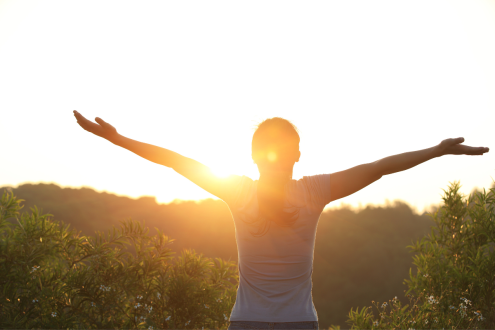How to reconnect with nature
Andréa Childs believed she was in touch with the natural world. But when she came across a new book, which suggests 365 ways to connect with nature, she realised her relationship could go much deeper

Living on the South Coast, I rather like to think I have a healthy relationship with nature. I run along the beach and the Downs several times a week… I walk my daughter to school through the local park… Heck, I am so in tune with the outdoors, I even went wild swimming in Spain last year.
So, when the book 365 Nature landed on my desk, promising ‘projects to connect you with nature every day’, I wasn’t daunted. I picked a selection to try over a month. Really, how difficult was this going to be?
The answer is, surprisingly tricky. I soon realised that treating the projects as items to tick off a to-do list didn’t work. I might get up with the sun, and go to bed when it’s dark, but beyond that, nature’s rhythms and mine diverge. My days progress at the rapid, unrelenting pace of 21st-century urban life: every minute seemingly scheduled; my focus too much on the computer screen or the phone, not the wider world outside my window. Nature refused to fit in with my timetable – the tides wouldn’t wait for me to reach the beach; the clouds didn’t converge when I had a moment to glance up at the sky.
As I began to delve deeper into the book’s pages, I realised that I tended to skim through nature, like a speeding car hurtling down a country road, the scenery a blur in the rear-view mirror. I had to learn to get out of the driving seat and properly connect with the world in the moment; to take off my headphones and run with nature’s soundtrack; to enjoy the rain and not wish for better weather. Or, as the book’s author, Anna Carlile, puts it: ‘Slow down. Simplify. Let go.’
Forage for edible weeds
We are on holiday on the Isle of Wight and there is a strong scent of wild garlic in the air. I task my two children, aged eight and 13, with collecting leaves. They’re surprisingly willing, although we’re careful not to damage the roots of the plants as we’re taking them from common ground. I head out with rubber gloves and kitchen scissors to harvest a patch of nettles.
In the book, Carlile gives a recipe for beetroot gnocchi with nettle pesto. I improvise and make wild garlic and nettle soup instead. There certainly is something satisfying about creating a meal from scratch from free foods.
Carlile came up with the projects in the book as a way to balance the buzz of living in the city, with the desire to immerse herself in the calm expansiveness of nature. ‘It’s about ways we can weave creativity, the environment and wild fun into everyday life,’ she says. For me, foraging hits the spot, not least because you don’t need to be in the countryside to do it.
Paint stones
With its shingle beach, my home town of Brighton is not short of stones to paint. Yet, I resist this activity at first, fearful of producing cack-handed, nursery-school daubs. ‘You will get your hands dirty, feel the sand beneath your feet, the wind in your hair and reconnect with days of old and childhoods past,’ says Carlile. Thinking this may be easier if I have the shield of childhoods present,
I take my daughter, her friend and a bag of paints, brushes and glitter glue to the beach. We have such a good time that I bring some stones home and paint them in the garden a few days later. It’s so peaceful to sit with
a pebble in one hand, a brush in the other – and the only decision that has to be made is where to put the next brushstroke. I put my favourite stone on my desk to use as a paperweight and, each time I see it, my mind feels that peace and clarity again.
Read the clouds
I love cloud-watching. Our house sits at the top of a hill, so there’s a big-sky feeling even here in the middle of the town. Of course, days can go by when I don’t remember looking upwards, but then I’ll go for a run and see sheets of rain falling from the steel-grey mass in the distance, or horsetails of cloud whipping upwards. But Carlile suggests we do more than view the clouds as airy ornamentation; she wants us to read the clouds so that we can forecast the weather.
I get a book out of the library and look at pictures of clouds with names like Harry Potter spells – altostratus opacus, stratus nebulosus – trying to commit them to memory. The next time I look up at the sky, my mind
is a blank. I persevere, taking snaps of the clouds so I can look them up when I get home. I correctly predict that the lovely, high, sheet-like white cirrostratus clouds I see are indicators of damp weather – and feel vaguely smug when I pack an umbrella in my handbag, ready for the drizzle.
Photograph nature
In the book, this section consists of simply a single quote by the American landscape photographer, Paul Caponigro: ‘Photography is a medium, a language, through which I might come to experience directly, live more closely with, the interaction between myself and nature.’ Caponigro is famed for his images of Stonehenge, sacred Japanese gardens and mystical woods, and has said how his images allow him, ‘if only for brief moments, to sense the thread which holds all things together’.
We hear so much about how our screens or cameras remove us from a direct relationship with the world: we photograph an experience, rather than living it – so I was interested to see whether taking images would make me feel more or less connected to nature. I began to take pictures of clouds in the sky, the tulips on my doorstep, the views across the Downs.
I realised that the act of framing a view, or crouching down to take a close-up of the dew on a leaf, is just as important as the end result. It’s about focusing on the beauty around me. What makes that view so compelling, or that wildflower really pretty? As a result, I don’t just look; I think about my place in the landscape.
Find a ‘sit spot’
The instructions are: ‘A “sit spot” is a place outdoors – a rock, a corner of the garden, or a park bench – that you go to often. While you’re sitting, open your senses. Look, listen, feel, smell, even taste, the natural world. Let it fill you, then go about your day.’
I knew where mine would be: a bench on the deck outside my office, with a garden view. I’d take a moment there at the beginning of the day, and drink it all in. Except it didn’t quite happen like that. This project meant developing a habit; giving myself permission to just sit. It is not easy when there are chores to do.
Taking a cup of tea out first thing seems to be the way. I’ve witnessed buds burst into bloom; I’ve felt the sea mist dampen the air; I’ve watched seagulls building a nest. I still worry about money and my children, but
I know there’s more going on than my ‘stuff’. Carlile says connecting with nature is ‘your entry into a world that spins slowly’. When life is moving too fast, that is a nice place to be.
Photograph: iStock








